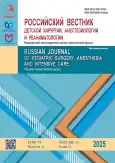Неблагоприятный исход деторсии придатков матки у пациентки 10 лет
- Авторы: Донской Д.В.1,2, Вилесов А.В.2, Ахматов Р.А.1,2, Гогичаева А.А.1, Соколов Ю.Ю.1
-
Учреждения:
- Российская медицинская академия непрерывного профессионального образования
- Детская городская клиническая больница святого Владимира
- Выпуск: Том 15, № 2 (2025)
- Страницы: 233-240
- Раздел: Клинические случаи
- URL: https://journal-vniispk.ru/2219-4061/article/view/313005
- DOI: https://doi.org/10.17816/psaic1897
- EDN: https://elibrary.ru/DDVTIS
- ID: 313005
Цитировать
Полный текст
Аннотация
На сегодняшний день не существует инструментальной и лабораторной оценки глубины ишемического поражения яичника при его перекруте. Диагностика жизнеспособности вовлеченных в процесс структур основывается на визуальной оценке состояния/цвета гонады и маточной трубы. В сомнительных случаях решение принимается в пользу сохранения органа, в надежде на восстановление его функции после операции. В данной публикации мы приводим клиническое наблюдение пациентки 10 лет, которая более 3 сут жаловалась на периодические боли в животе. В районной больнице на операции был устранен перекрут придатков справа. Но в послеоперационном периоде боли в животе продолжали беспокоить, и через 19 сут она была госпитализирована. При лабораторном исследовании обнаружены повышение концентрации глюкозы крови, признаки гиперкоагуляциии и активного тромбообразования. При ультразвуковом исследовании позади мочевого пузыря визуализируется фиксированное аваскулярное образование размерами 71 × 58 × 89мм. Выполнена повторная лапароскопическая операция: при ревизии в полости малого таза выявлен инфильтрат, сформированный правым яичником, сигмовидной кишкой и большим сальником, правый яичник отделен, имеет серый цвет, без признаков реторсии и кровоснабжения, удален после пункции. Гистологическое заключение: некроз ткани яичника. Послеоперационный период протекал без осложнений. Сохранение болевого синдрома после деторсии придатков матки, отсутствие кровотока в пораженном яичнике при трансабдоминальном ультразвуковом исследовании, снижение активированного частичного тромбопластинового времени, высокие показатели фибриногена и растворимого фибрин-мономерного комплекса могут указывать на необходимость выполнения интервальной лапароскопии.
Полный текст
Открыть статью на сайте журналаОб авторах
Дмитрий Владимирович Донской
Российская медицинская академия непрерывного профессионального образования; Детская городская клиническая больница святого Владимира
Email: dvdonskoy@gmail.com
ORCID iD: 0000-0001-5076-2378
SPIN-код: 8584-8933
канд. мед. наук
Россия, Москва; МоскваАлексей Владимирович Вилесов
Детская городская клиническая больница святого Владимира
Email: vilesov.alexej@yandex.ru
ORCID iD: 0009-0001-4545-9590
SPIN-код: 2081-3871
Россия, Москва
Роман Анатольевич Ахматов
Российская медицинская академия непрерывного профессионального образования; Детская городская клиническая больница святого Владимира
Автор, ответственный за переписку.
Email: romaahmatov@yandex.ru
ORCID iD: 0000-0002-5415-0499
SPIN-код: 9024-8324
Россия, Москва; Москва
Алания Александровна Гогичаева
Российская медицинская академия непрерывного профессионального образования
Email: gogichalani@gmail.com
ORCID iD: 0000-0003-3614-6493
SPIN-код: 2124-5942
канд. мед. наук
Россия, МоскваЮрий Юрьевич Соколов
Российская медицинская академия непрерывного профессионального образования
Email: sokolov-surg@yandex.ru
ORCID iD: 0000-0003-3831-768X
SPIN-код: 9674-1049
д-р мед. наук, профессор
Россия, МоскваСписок литературы
- Adeyemi-Fowode O, McCracken KA, Todd NJ. Adnexal torsion. J Pediatr Adolesc Gynecol. 2018;31(4):333–338. doi: 10.1016/j.jpag.2018.03.010
- Geimanaite L, Trainavicius K. Ovarian torsion in children: management and outcomes. J Pediatr Surg. 2013;48(9):1946–1953. doi: 10.1016/j.jpedsurg.2013.04.026
- Adamyan LV, Dyakonova EYu, Sibirskaya EV, et al. Surgical approach in cases of adnexal torsion in children. Pediatric and adolescent reproductive health. 2014;(4):35–41. EDN: SYPHKP
- Celik A, Ergün O, Aldemir H, et al. Long-term results of conservative management of adnexal torsion in children. J Pediatr Surg. 2005;40(4):704–708. doi: 10.1016/j.jpedsurg.2005.01.008
- Rossi BV, Ference EH, Zurakowski D, et al. The clinical presentation and surgical management of adnexal torsion in the pediatric and adolescent population. J Pediatr Adolesc Gynecol. 2012;25(2):109–113. doi: 10.1016/j.jpag.2011.10.006
- Tielli A, Scala A, Alison M, et al. Ovarian torsion: diagnosis, surgery, and fertility preservation in the pediatric population. Eur J Pediatr. 2022;181(4):1405–1411. doi: 10.1007/s00431-021-04352-0
- He Y, Ji C, Shen X-C, et al. Rethinking ovary preservation by adnexal torsion reversal in adolescents: a case of delayed diagnosis. BMC Womens Health. 2022;22(1):421. doi: 10.1186/s12905-022-02013-4
- Poonai N, Poonai C, Lim R, Lynch T. Pediatric ovarian torsion: case series and review of the literature. Can J Surg. 2013;56(2):103–108. doi: 10.1503/cjs.013311
- Castro Trindade RM, Baroni RH, Rosemberg M, et al. Magnetic resonance imaging findings in adnexial torsion. Einstein (Sao Paulo). 2010;8(1):92–96. doi: 10.1590/S1679-45082010RC878
- Walker SK, Lal DR, Boyd KP, Sato TT. Management of pediatric ovarian torsion: evidence of follicular development after ovarian preservation. Surgery. 2018;163(3):547–552. doi: 10.1016/j.surg.2017.11.019
- Fujishita A, Araki H, Yoshida S, et al. Outcome of conservative laparoscopic surgery for adnexal torsion through one-stage or two-stage operation. J Obstet Gynaecol Res. 2015;41(3):411–417. doi: 10.1111/jog.12534
- Kula H, İlgen O, Kurt S, Yılmaz F. Effects of allium cepa on ovarian torsion-detorsion injury in a rat model. Turk J Obstet Gynecol. 2023;20(2):137–141. doi: 10.4274/tjod.galenos.2023.41763
- Ngo A-V, Otjen JP, Parisi MT, et al. Pediatric ovarian torsion: a pictorial review. Pediatr Radiol. 2015;45(12):1845–1855. doi: 10.1007/s00247-015-3385-x
- Lee S, Jackson RM. Reactive species-specific mechanisms of cell damage during hypoxia-reoxygenation. Am J Physiol Cell Physiol. 2002;282(2):С227–C241. doi: 10.1152/ajpcell.00112.2001
- Laganà AS, Sofo V, Salmeri FM, et al. Oxidative stress during ovarian torsion in pediatric and adolescent patients: Changing the perspective of the disease. Int J Fertil Steril. 2016;9(4):416–423. doi: 10.22074/ijfs.2015.4598
- Silberstein T, Freud A, Baumfeld Y, et al. Influence of ovarian torsion on reproductive outcomes and mode of delivery. Front Med (Lausanne). 2024;11:1370409. doi: 10.3389/fmed.2024.1370409
- Dyakonova EY, Fisenko AP, Bekin AS, et al. Laparoscopic operations in emergency pediatric surgery. Moscow: NMIC of Children’s Health of the Ministry of Health of Russia; 2019. 160 p. (In Russ.)
- Adnexal torsion in adolescents: ACOG Committee opinion no, 783 summary. Obstet Gynecol. 2019;134(2):435–436. doi: 10.1097/AOG.0000000000003376
- Elrod J, Heuer A, Knopf J, et al. Neutrophil extracellular traps and DNases orchestrate formation of peritoneal adhesions. iScience. 2023;26(12):108289. doi: 10.1016/j.isci.2023.108289
- Lu Y, Elrod J, Herrmann M, et al. Neutrophil extracellular traps: A crucial factor in post-surgical abdominal adhesion formation. Cells. 2024;13(11):991. doi: 10.3390/cells13110991
Дополнительные файлы









